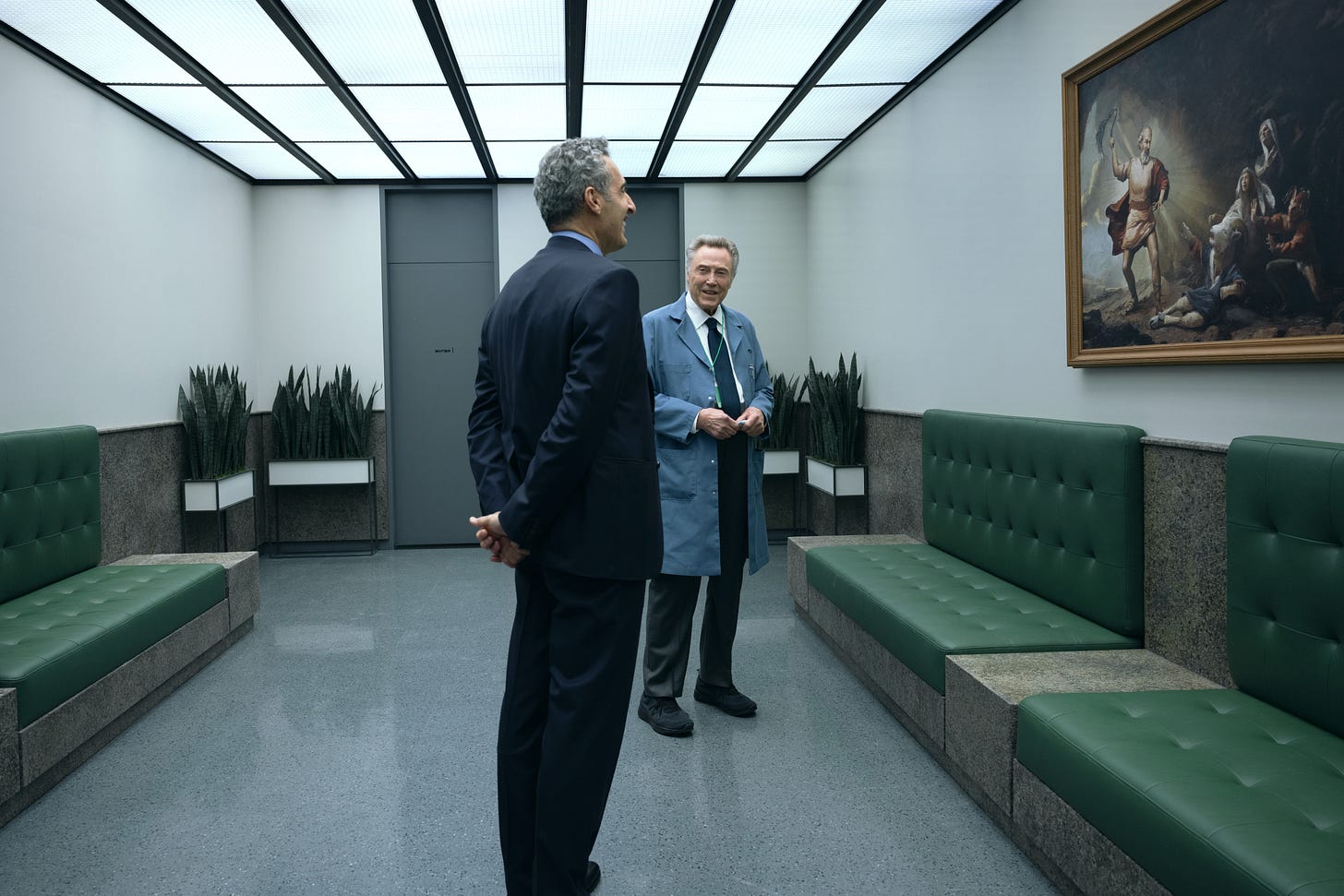Rewind Review: Severance, "Half Loop" | Season 1, Episode 2
The drama's second episode reveals more "innie" workings of its workspace
In the lead up to the second season premiere of Apple TV+’s Severance, I’m sending subscribers my reviews of the first season, which were the first I wrote for the newsletter.
To join the conversation in the original reviews (you can find the comments at the link above), read them faster than the weekly emails, and make sure you receive my coverage of season two, become a paid subscriber today.
In its premiere, Severance dispensed with mystery regarding Mark’s decision to be severed: his sister Devon lays it out plainly, calling out her brother for thinking that eight hours separated from his grief from his wife’s death is a replacement for actual healing (or therapy). But his co-workers are their own mysteries, and we learn precious little about them: Dylan is motivated by perks, and Irving is a bit of a stick in the mud, but there’s no insight into their identities.
This is different for Helly, whose arrival is used to mirror our own disorientation with this space. And “Half Loop” doubles down on this by opening on Helly much as the premiere did, but this time showing us the moments leading up to her severance now that the show doesn’t need to obscure some of the details we learn during her orientation. We get our best look at the stone visage of the illustrious Mr. Eagan, the logic behind that weird question about his favorite breakfast (a test to see if they remember the conversation they just had), and a suitably harrowing glimpse of a small micro-chip entering Helly’s brain. And then we learn Helly wasn’t entering a trick staircase when she tried to escape: she was entering a real one, but her outside self knows she’s supposed to be in there, and Milchick is there to help her confront the realization that the work self she created is fighting against her own desire to do whatever work Lumon wants her to do.
Milchick tells Helly that her decision to work for Lumon was received as a “miracle,” implying that whatever work she thinks she’s doing carries some type of social importance. But the show remains mum on the details, largely allowing Helly’s outside life to be as obscure as Irving or Dylan’s. But we are meant to believe that they all have their own version of Mark’s struggle: the newly introduced opening title sequence may only feature Mark, but the idea is that the same principles applies for every severed individual. They’re striking titles I expect will earn an Emmy nomination this summer, taking on a sort of video game-like aesthetic to mirror the way their work selves become void avatars to be moved around as Lumon wills.
And while I am officially on the record that the “Skip Intro” button is a scourge against the art of the title sequence, I also hypocritically wish that I had chosen to skip these ones, and then come back to them in the following episode. Because as “Half Loop” fleshes out the “work world” that half the show will be operating in with Helly’s welcome party and more insight into Irving’s work life, the show casually introduces the inimitable Christopher Walken as Burt, whose presence reveals the existence of other departments we haven’t seen and which Irving will be our window into exploring. And although I realize he is in the trailers I didn’t watch, I have to admit that I wish I could have experienced the sheer joy of “Surprise Christopher Walken” in that moment, and frankly I’d have been similarly appreciative if the appearance of Dichen Lachman that came along with it had been a surprise as well. 1 But instead, the credits basically spoiled their presence, and I spent the episode anticipating their arrivals.
I raise this point not because it ruined the episode, but rather because Severance is a show that is very careful about how it’s doling out information, which made the “spoiler” in the credits counter-intuitive if not destructive. With most of the big picture details about the procedure and Lumon’s operations set up, “Half Loop” invests in smaller bits of worldbuilding, whether it’s Mark’s morning routine and its bizarre assemblage of menial tasks or the particular absurdity of an icebreaker activity when you have no conception of your identity outside of work. “Half Loop” also starts building out the mythology that the “Innies” are surrounded by, as we come to understand that their world is governed by the specter of Kier Eagan, whose philosophies are plastered on the walls, and whose image is worked into the paintings that Burt places around the facility. And we also get our first glimpse of spaces like the Break Room and the Wellness Center, critical tools in Lumon’s efforts to keep their severed workers compliant and, well, whole.
Severance’s critique of work culture gets more pointed in the process. While evident in the premiere, Mark’s casual explanation to Helly that “quitting” would effectively be a form of suicide underlines how Lumon’s plan is to create the ideal worker so defined by their job that they can’t imagine themselves outside of it. The old technology is meant to disrupt their understanding of not just who they are on the outside, but everything about it: Dylan tries to imagine what they’re doing by “cleaning” this data and presumes a climate apocalypse (which, fair), while the facts Helly and Irving learn about their “outies” are absurdly opaque. But as Irving’s “dozing” indicates, this is not something that the severance process creates in perpetuity: it is the instinct of humans to extend their identities beyond their work, and so there are wellness visits for those who need to be recentered, and the break room’s more forceful approach for those who need stronger correctives.
Petey helps Outside Mark understand some of this by playing him a recording from the Break Room, but he doesn’t have the answer that would help piece all of this together: what, exactly, they’re doing on the severed floor. The Macrodata Refinement team is separate from the others, and while we learn that’s part of the strategy we still don’t get a clear picture of the scale of the operation. And while Cobel, Milchick, and Graner are certainly enforcing the closed system through their actions, their own agency (and connections to outer selves) is less clear, outside of Mrs. Selvig continuing to insert herself into Mark’s life and surveil his house as he moves Petey into his basement.
But what’s clear is that with each subsequent episode, Severance will peel back the layers of consequences to all of this. When Mark runs into the “Whole Mind Collective” on his date with Devon’s doula, it’s one more glimpse into the public debate on the subject of the procedure, but we’re getting to see the lived reality of this through each character, in particular John Turturro’s Irving in this outing. While a fairly minor presence in the premiere, his rule-following gains greater nuance here. More than any other, he has accepted the mythology of the world he’s operating in, internalizing the nine principles of working at Lumon so much that he can’t pick a favorite. And yet despite this, whether due to his age or simply the reality of the procedure, he’s the one who’s dozing, and who is forced to the Wellness Center to calm his brain’s knowledge there’s another version of himself out there. But when he gets excited at the idea of this person, when he starts to feel things about who he really is, he’s punished and threatened back to ignorance. Turturro isn’t able to play the same range as those who get both outer and inner lives, but that’s critical to the character, and I’m curious how the performance evolves as the character struggles to.
“Half Loop” ends with a clear sign that “re-integration sickness” is more than just a few headaches, and that whatever Petey has done has created a significant disturbance in the mind-space continuum. But it also shows that there are constantly smaller versions of that disturbance, whether “code detection” violations or ooze-filled dozings, and Lumon has developed a system to contain them. It’s evident Severance is the story about those disturbances being unleashed, but it will be interesting to see how the show balances the pending instability with the continued desire to mine the nuances and oddities of this liminal workplace.
Stray observations
Whereas the premiere was very deliberate about moving in and out of the office space, Mark calling in sick meant cross-cutting between the two spaces, which sort of mirrors Petey’s blurring of the two worlds.
We might see her severance process, but Outside Helly doesn’t make another appearance, while Inside Helly learns about and gains the ability to see the “scary” data that needs to be cleaned.
I wondered when I saw the team photos if they had been there in the premiere, and technically revealed Petey’s identity before he did: however, we only really see them at a distance, and the one closeup—when Mark turns on his Crystal Head Cube—cuts off the left side of the frame.
“No trust fall today, Irv”—Irv loves a trust fall.
Still trying to figure out if Milchick is himself severed or not—he clearly has a degree of sentience that the workers don’t, but maybe that’s just part of his training? Something about the way he presented the facts about Hellie—allergic to almonds, weak enamel, shoulder-length hair—gave a real severed edge, but maybe that’s part of the disorientation of it all.
It’s interesting that they seemed unprepared for Mark to object to the suggestion Petey’s departure was just like Carol D.’s, given they knew she was leaving, and her outie even left a message. Does this imply that Lumon used to actually let employees leave their jobs, and that something has changed?
Mark’s date with the doula didn’t seem to go well, but the doula was played by Tony winner Nikki M. James, which is usually a sign we’ll be seeing a character again.
“I find it helps to focus on the effects of sleep because we don’t get to experience it”—between that and the surgery scene, this episode had some triggers as someone who recently had emergency surgery (I’m fine) and more or less didn’t sleep for a week.
I’m curious about the decision not to include the title sequence for the first episode, and the choice to use it after a cold open with Helly here. It contains some imagery that wouldn’t make sense without the cold open (the needle they used to insert the microchip) but it also foreshadows the black goo Irving witnesses.
I’d buy a “Burt’s not a fuck!” t-shirt.
It’s hard not to play the intertextuality game with Lachman’s breakout role in Dollhouse here, given the subject matter.





